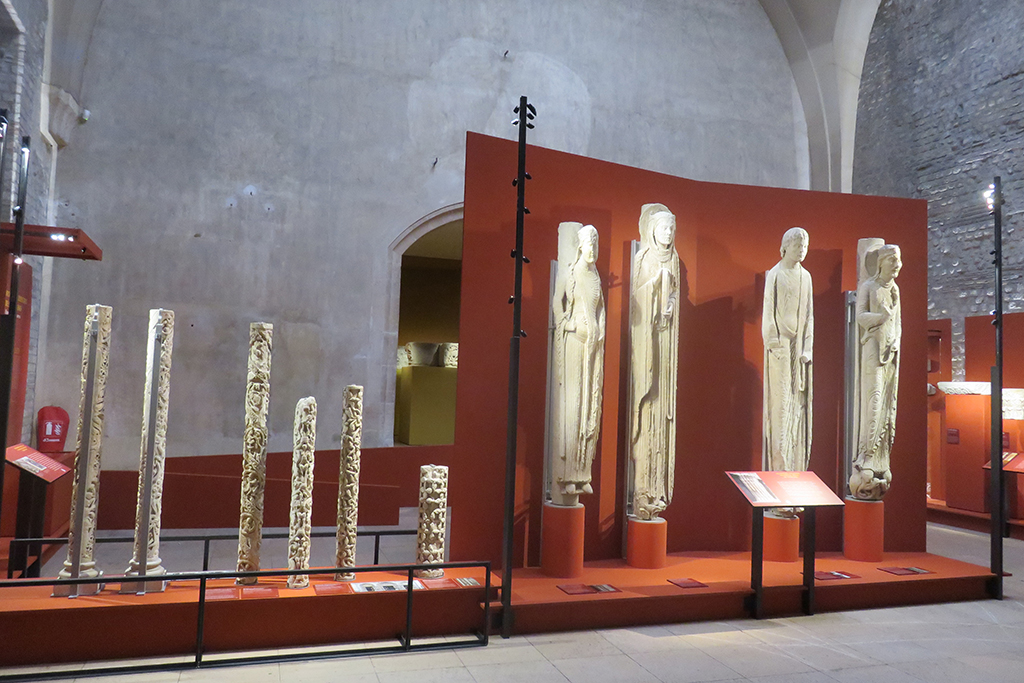Restoration of Column Statues

Over the course of its history, the Royal Portal of Chartres Cathedral has undergone significant modifications, mainly due to the weathering of the stone and the various restoration campaigns, some of which date back a very long time.
In 1984, Léon Pressouyre documented two 12th-century elements: the head of the bearded king in the left splay of the north portal and, at his feet, a small female statue placed on the column like a marmoset. He also pointed out that the heads of the queens in the same splay were rebuilt as early as the 1300s for the left one, and probably around 1400 for the right one.
By 1696, five of the twenty-four column statues had disappeared for unknown reasons. They are missing from the drawing in the documents collection of François-Roger de Gaignìeres (1642-1715). These statues most probably included the one taken in the 16th century to be transformed into a “dial angel” at the corner of the south tower, as well as the lower part of another, now preserved in the lapidary reserves.
In 1848, diocesan architect Jean-Baptiste Lassus noted that “the stone of the statues, columns and colonnettes is decomposing and turning to dust”. He did everything in his power to preserve the authenticity of the ensemble by restoring it without further removal. His successor, Émile Boeswillwald, made a very different choice, opting to remove the archivolts of the three bays, which were replaced by copies in 1858-1859. In addition to the original voussoirs, the lapidary repository also contains a replaced segment of an abacus.
Despite restoration campaigns in the 19th and 20th centuries, the stone was in “deplorable condition, reduced to a flaky paste on certain edges”, and removal of some column statues were necessary between 1967 and 1975: a canopy, the “angel with a dial”, five column statues . These and four column segments were removed and stored in a chapel in the crypt and replaced by stone copies. Today only fourteen of the original column statues remain on the portal, five smooth columns from the 19th century and five 20th-century copies.
In autumn 2017, the Directorate for the Conservation of Historic Monuments of the Centre-Val de Loire Region undertook the restoration of all the sculptures deposited in the crypt. A detailed study of the condition of the stone was carried out to define the most appropriate conservation protocol. Subsequently, every trial and intervention phase were carefully monitored and evaluated.
The cleaning technique consisted of a mixed method. The statues were first subjected to a gentle micro-sandblasting, one single intervention at very low pressure, excluding areas that were too fragile. This operation removed some of the black deposits from the surface of the stone, without seeking to achieve a high level of cleaning. As a finishing touch, laser cleaning was carried out on a lightened sulfo-calcin to reduce the risk of staining the stone. The laser was also used to complete the cleaning of fragile areas.
Structural interventions were also carried out: removal of deposits and cement where possible without causing any risk to the sculptures, infiltration of grout into cracks, consolidation flashings. Finally, stone samples were taken to trace salts to refine the diagnosis and plan long-term monitoring of the state of conservation.
The restoration of the Royal Portal carried out between 1981 and 1983 by Ottorino Nonfarmale had revealed the presence of vestiges of polychromy. Therefore, particular attention was paid to this issue during the conservation intervention. Despite the deterioration of the epidermis, largely due to the positioning of the statues outside the sashes, the restoration of the queen of the south door revealed the presence of an intense blue on part of the column protected by the drapery and a bright red on the base, between the statue’s feet.
The restoration of these sculptures has enabled us to appreciate once again the quality and finesse of this ensemble which, despite the ravages of time, remains one of the most outstanding milestones of medieval sculpture.
American Friends of Chartres contributed €50,000 for the restoration of the column statues.
Translated by AFC, from the article by Fabienne Audebrand and Irène Jourd’heuil, in Naissance de la Sculpture Gothique, Catalogue of Cluny Museum Museum, 2018.
restore and preserve the cathedral of Notre-Dame de Chartres
Your contributions are tax deductible in the United States to the extent allowed by law.

